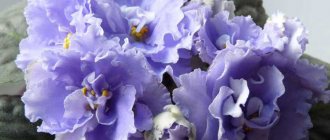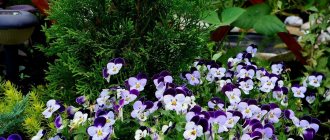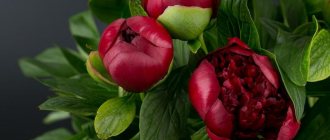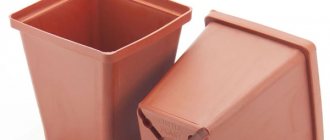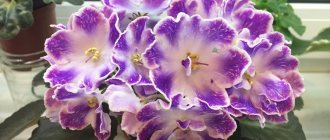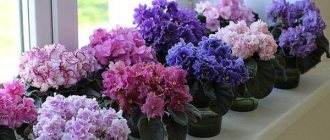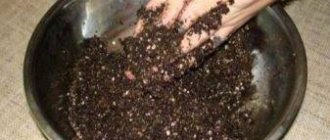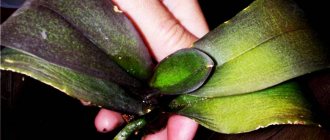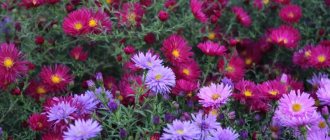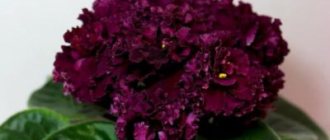Brief biography of the breeder
E.V. Korshunova is one of the most famous Russian breeders. She lives and works in Tolyatti. From a childhood passion for flowers, the selection of violets became the work of her whole life for E. V. Korshunova. Back in the mid-90s, the first variety bred by her appeared. It created a real sensation and was called “EK Bullfight”. Then there were many new varieties.
Violets selected by E. V. Korshunova
Pink, red and crimson indoor violets
Saintpaulia, or Usambara violet Rebel's Two Cents (R. Bann)
The flowers are large, semi-double, pink with a fringed edge. Variegated: leaves are white and pink.
Saintpaulia Rebel's Two Cents
Saintpaulia, or Uzambara violet EK - Goddess of Beauty (Goddess of Beauty, E. Korshunova)
The flowers (up to 7 cm in diameter) are double, bright pink with a purple coating. The rosette is dark green. Standard.
Saintpaulia EK - Goddess of Beauty (E. Korshunova)
Saintpaulia, or Uzambara violet RS-Cabaret (S. Repkina)
Semi-double flowers are dark fuchsia with a white edge and a white eye.
Saintpaulia RS-Cabaret
Saintpaulia, or Uzambara violet LE-Fuchsia Ballerina (E. Lebetskaya)
The flowers are raspberry-fuchsia in color with a white border along the edge, double.
Saintpaulia LE-Fuchsia Ballerina
Saintpaulia, or Usambara violet Curly Sue (K. Morev)
Pink double flowers with apricot tint. The leaves are green. Standard.
Saintpaulia Curly Sue (K. Morev)
Konstantin Lvovich Morev is a famous Moscow breeder of Uzambara violets. Has been working in this field since 1994.
Saintpaulia, or Uzambara violet Shanghai rose (E.V. Korshunova)
The flowers are large, densely double dark red flowers with a wide white border. The socket is compact.
Selection of Elena Vasilievna Korshunova
Violet Le - description, varieties and characteristics of varieties
E.V. Korshunova managed to consolidate recessive traits in plants (for example, the bright red color of the EK Bullfight variety). Considering that the selection of one variety requires at least 3 years, it becomes clear what kind of hard work is characteristic of the breeder, because there are about 200 varieties of Saintpaulias bred by her. Popular varieties: EK Marigold, EK Cornflower Blues, EK Cherry Gravure, EK Nevsky, EK Lights of Venice, EK Snowy Carpathians.
Characteristics of varieties
Violet Frosty cherry - description and characteristics of the variety
Today violet EK is a well-known brand in the world of flower growers, famous for its successful plant varieties.
Endorphin
The flowers of the violet EK Endorphin are cherry-coral in color with pink specks and white edging around the edges. Flower type: semi-double.
Kurazh (fialka kurazh)
A wide white border surrounds very large, double flowers. The shade is red and coral. Violet EK Courage blooms profusely, forming an airy, lush cap of inflorescences.
What does violet EK Courage look like?
Expensive truffle
EK Expensive truffle is a violet, the color of its flowers ranges from lilac to purple. The structure of the flower is specific. There are small inclusions of a light shade. The leaves have an interesting color. The dominant shade is dark green. A characteristic feature is a deep purple tint around the edges. The flowers are double and large.
Argentine tango
EK Argentine tango is a violet with flowers up to 7 cm in diameter. A dark ruby shade with an intermittent white edge. The petals are corrugated, semi-double, the leaves are dark emerald green, the center of the rosette is lemon.
Argentine tango variety
Crimson Peony
Bright red flowers, double. The leaves are rich green and have a creamy edge. EK The crimson peony blooms profusely.
Black magnolia
Petals range from dark ruby to black. Rosette with variegated leaves and gold leaf. The shade of the leaves is characterized by a transition to pink-golden color in the center of the rosette.
Note! Black-green leaves form a show rosette.
Pink lotuses
The variety has green outer petals and a pink center. Leaves are rich green. Large and double flowers, the variety blooms profusely.
Roses in the snow
Fantastic combination of white and dark red shades. The edges of the petals are slightly greenish. Exhibition variegated foliage is dark green, turning to purple.
Mrs. Blizzard
Variety EK Mistress snowstorm is terry, slightly wavy, snow-white color, rosette color is bright green.
Variety Mistress snowstorm
The sky is in diamonds
The description of the variety suggests flowers of a delicate blue hue with dark blue veins, wavy and large. The leaves are variegated, green with a wavy cream edge.
On a note! The variety differs in the scale of flowering. A real diamond in the gardener's collection!
Champion
EK Champion is distinguished by velvety flowers of a dark red hue. The inflorescences are double and voluminous. The leaves are dark green with a cream-colored edge. It has a long flowering period with a characteristic bouquet-like shape.
Goddess smile
Variety EK Smile of the Goddess – fantasy. The petals are pinkish-lavender, the flowers are ruffled, wavy, with a rich purple border. The leaves are green. Flowering occurs in the form of a bouquet.
Variety Smile of the Goddess
Cardinal
The violet variety EK Cardinal is known for its large flowers (their diameter reaches 8 cm). The shade of the petals is deep ruby. Variegated leaf with a golden tint.
Bereginya
Violet EK Bereginya has dense double pink inflorescences with a white border and eye. Leaves are rich green.
Dreamer
EK Fantasy is characterized by large inflorescences (diameter up to 6 cm) in a variegated pink and blue color palette. A rosette of leaves of rich dark green color.
Variety Fantazerka
Robinson Crusoe
Violet EK Robinson Crusoe immediately attracts attention with its bright cornflower blue color. The leaves of the plant are serrated, deep green in color with a yellow-cream edge.
Robinson Crusoe variety
Home of God
The variety is distinguished by large double lavender flowers, corrugated and wavy along the edge. The leaves are green in color with a lilac-yellow edge.
Characteristics and features of varieties
Forest violet - description, varieties and characteristics of varieties
The presented varieties amaze with their unique appearance, as well as interesting names. Each flower has its own characteristics and distinctive features.
Endorphin
Endorphin is a violet with large flowers of rich cherry color. Petals are semi-double and notched. There is a white border around the edges. The leaves are dark green with coffee-pink splashes.
Violet EK Endorphin is named after the hormone of happiness, joy and euphoria
Courage
Variety Kurazh with large leaves of bright red color. There is a wide white border. The rosette is formed from dark green, jagged leaves. EK Courage is a violet with a large voluminous “cap”. Translated from French, courage means courage and bravery.
Expensive truffle
EK Dear Truffle is a violet with large purple leaves. The surface is terry with rounded shapes. There are small splashes of light fantasy. The edges are finished with broken white fringe. The leaves are dark green with purple-cream edges. There are dark inclusions on the sheets in the center of the rosette.
Interesting! The violet is named after a valuable delicacy.
Argentine tango
EK Argentine tango is a violet with a diameter of up to 7 cm and a dark burgundy color. The surface is semi-double with a wavy edge. Golden variegated leaves and deep green long leaves. The center of the rosette is decorated in lemon color. Considered one of the most beautiful EK varieties.
Crimson Peony
The crimson peony is represented by very large flowers in a crimson-red hue. The surface is thick and terry. Variegated leaf with green leaves and cream border. Blooms profusely and beautifully.
Black magnolia
Black magnolia is distinguished by its deep ruby flowers. Grows on a show black and green rosette with golden variegation. It is considered a precious and unique variety.
Pink lotuses
Violet EK is presented with a pink inflorescence. The surface is terry. Green outer petals are present. Blooms in abundant and beautiful clusters. Violet leaves are rich green.
Roses in the snow
Large variety with dark red inflorescence. The edges have a white wavy edging with a light green tint. Show variegated leaf is dark green with pointed, toothed leaves.
Mrs. Blizzard
Mrs. Blizzard is presented in snow-white color. Huge double flowers with slight wavy edges. With their impressive size and beauty they resemble roses. Rosette in a bright green shade.
The sky is in diamonds
The diamond is presented with large blue flowers, with a wavy edge along the edges. Blue stripes are visible in the center of the inflorescence. Variegated leaf with pointed, cream-colored leaves and edges.
Interesting! Diamond blooms almost constantly lushly and abundantly.
Champion
Violet Champion in a dark red shade. The flowers are double and voluminous, resembling balls. Exhibition rosette with dark green leaves. A creamy-lilac border is visible along the edges. It blooms for a long time in one bouquet.
Goddess smile
The smile of the goddess is a violet with large double flowers. Presented in a soft lavender shade, with ruffled lilac trim along the edges. The rosette is rich green, exhibition.
Blooms in a small bouquet
Cardinal
Cardinal is considered one of the largest varieties. The diameter of the inflorescence is 8 cm. The flowers are semi-double, dark ruby in color with veins. Golden variegated leaf. A rosette with elongated dark green leaves at the edges, towards the center the shade turns to golden sand.
Bereginya
EK Bereginya is a violet with large double flowers of a bright pink hue. There is a white wavy border. The leaves are quilted and deep green. Flowering occurs throughout the year in a lush bouquet. The variety is named after the ancient image of female power.
Dreamer
A dreamer with double pink flowers, up to 6 cm in diameter. Blue-violet splashes on the surface of the inflorescence give an unusual look. The exhibition rosette is dark green.
Robinson Crusoe
Robinson violet with double petals in a blue shade. A small amount of pink markings are present. The leaves are green and toothed, with cream colored edges.
Home of God
Vialka with large, semi-double purple petals. The edge is wavy, highlighted in a darker shade. The leaves are rich green with a slight purple edge. Externally, the flowers of this violet resemble carnations.
Recommendations for planting and care
Violet Summer Twilight - description and characteristics of the variety
Violets are indoor plants. Comfortable temperature is 20-25 ℃. Exposure to scorching sunlight and drafts is contraindicated. But in general the plant is light-loving. The air is humidified to 50-60%. EK Courage-violet is grown in pots.
Difficulties in caring for the plant:
- Provide a sufficient degree of air humidification.
- Avoid overcooling the root system when growing on a windowsill in winter.
- Provide suitable air temperature.
Features of reproduction
The method of propagation by leaf cuttings (rooting in water) is often used. The leaves are cut from the mother plant, rooted (from 2 weeks to 1 month), covered with a bag. Carry out careful drip irrigation. After rooting, replant.
Additional Information! Using a similar scheme, leaf cuttings are rooted in a substrate (perlite and soil mixture 3:1). The method is suitable for not very high-quality planting material.
When propagating violets, the planting procedure is carried out when shoots with a diameter of up to 5 cm appear at the base of the cuttings. If it is not possible to purchase a ready-made substrate, prepare the soil for planting yourself. To do this, mix peat, river sand, leaf debris, perlite or special moss in equal proportions.
New Canadian roses in Siberia!
I had to keep a big secret for two years!
In 2022, I was invited to test new varieties of roses developed through the joint work of Canadian and Altai breeders. The seedlings were grown (from whom I have been buying seeds and seedlings for my small store for many years) near the city of Barnaul. I was provided with ten seedlings of five varieties of Canadian roses, which had no name (I had to look for a place on the site and even uproot an old currant bush). The task was to grow roses on my personal plot - cold, little fertile and often without snow - and as a result, make a verdict on the frost resistance of roses and the qualities of the varieties. Since the varieties did not have a name, I numbered each one. I planted all the roses in holes 35-40 cm deep, deepened them and slightly hilled them up (in summer and autumn I added soil so that the seedling always had a hill 10-15 cm high). I didn’t use drainage because the soil on my site contains a lot of sand and the water drains out very quickly.
Roses in the first year after planting
Unfortunately, it so happened that in the summer of 2022, after planting the roses, I fell ill and could not properly care for the roses. But the new Canadian-Siberian varieties pleased us with their incredible vitality! All the roses survived, despite the lack of watering, even on the hottest days (in summer the temperature rose to +37C!).
In the first year, all the roses bloomed (I did not remove the buds). The roses numbered 2 and 4 pleased everyone the most. This year I found out that these are the varieties “Quebec” and “Montreal”. This is the information “Seeds of Altai” provided me: “The climbing rose Quebec is the result of complex work on selecting the best seedlings of the climbing rose of the paternal variety William Baffin, from which the rose received high protection against diseases, frost resistance, and the maternal line of a yellow-colored rose of a consolidated form with practically non-fading petals. Increased doubleness has been established. Rose "Quebec" has been tested in the dry-steppe, foothill and forest-steppe zones of Western Siberia in a two-year experiment. High frost resistance and survival rate of 94.2% were established in snowless winters and light cover with spruce branches. In the forest-steppe zone, survival rate reached 98%. The rose was named after Canada's first and largest province, Quebec, symbolizing wealth and respect."
Rose "Quebec" in the second year after planting In the winter of 2018-2019, the roses overwintered without shelter and even without pruning. The winter turned out to have little snow, and some of the climbing roses froze above the snow level. I thought that was it - I was left without roses! But imagine my surprise when in the spring, back in April, the roses began to actively grow! And each of them survived the winter without shelter or pruning. The coldest day was January 19 (that’s why it’s Epiphany!) -39C! In the summer of 2022, climbing roses pleased with unprecedented growth! I had to build a support so that the lashes would not break under the weight of the buds. My favorite of all is the double rose “Montreal” (I had number “2”). The rich yellow rose has grown to 180 cm, the bush has also grown very much in width, to 110-120 cm. The aroma is incredible! I remembered rose water brought from Bulgaria in the early 2000s. I have never heard such richness from a yellow rose.
Here is what they write about the variety “Seeds of Altai”: “The result of breeding work to select the best traits of stable, powerful varieties of Canadian roses. Montreal received high frost resistance and an incredibly strong stem from the classic rose variety “Jens Munch”. The new variety has a more powerful climber bush structure, which can be grown as a scrub with annual low pruning. The plant is very powerful; when two-year-old seedlings were planted, already in the first year at the end of the growing season the height reached 200 cm. The color of the new variety also changed. "Montreal" has double cup-shaped flowers of bright yellow, sunny color, which gradually changes to lemon. The frost resistance of this rose was tested at an experimental agro demo site during wintering in the field without pruning or covering. The percentage of rose regrowth in spring will be 92.2%, with light cover with pine spruce branches and artificial snow retention - 100%. During the experiment, a high turgor of cut buds on a stem 50 cm high was established. The period before wilting was 7-10 days. Decorativeness was assessed according to a modified 100-point scale and included the following parameters: “color”, “elegance of form”, “aroma”, “number of flowers on the stem”, “flower diameter”, “doubleness”, “plant habit”, “stability” to diseases and pests”, “resistance to weather conditions”, “flowering duration”. As a result of evaluation by independent experts, the average total score for the Montreal rose was 92.4 points.”
Rose "Montreal" in the second year after planting
For a long time I couldn’t tell you about the results, but now I was allowed to write a review, because... This year “Seeds of Altai” begins selling seedlings of Canadian roses hardened in Siberia! I definitely understood for myself that Canadian roses are what you need if you can’t take care of the garden, but you really want such beauties to decorate the area, because they can easily winter without shelter!
Problems that a florist may encounter
You should always pay close attention to the condition of the plants. It is important to promptly prevent the spread of diseases and pests. Diseases relevant to Saintpaulia ek:
- fungal diseases;
- root rot;
- stem rot;
- leaf rust;
- gray rot;
- late blight;
- powdery mildew;
- vascular bacteriosis.
Additional Information! Due to elevated temperatures, red mites may appear in the flower. When the first “guests” appear, the violets are immediately treated with insecticidal agents.
Typical pests:
- flower thrips;
- cyclamen mite;
- aphid;
- scale insects;
- woodlice;
- sciarids;
- nematodes.
After purchase, it is recommended to replant the plant and inspect the soil. If pests are noticed, the soil is replaced with a better quality one. If the roots have sprouted through the drainage holes, change the flower pot.
